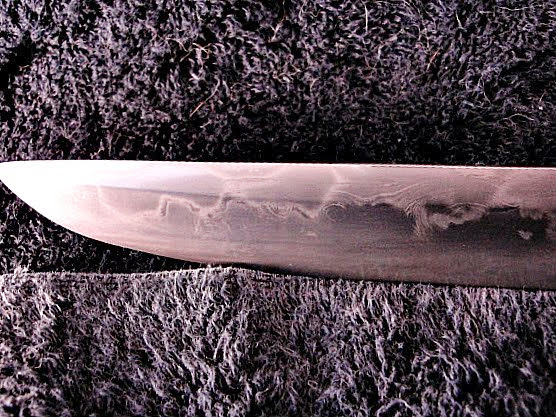- Joined
- Dec 18, 2008
- Messages
- 760
Greetings Everyone,
I have been working hard on this one for many months. Making this one, and making it as a sole author, was a challenge. I spent several months learning how to engrave with tagane and with Western-style gravers. I snagged an Ngraver hammer handpiece and a low-speed, high-torque foredom to drive it. This, plus some hot glue and a 15lb shaft cutoff gave me the setup needed for engraving and adornment.
The blade is in the style of the Ming Dynasty. There was clay heat treatment in China as well as Japan, though there was less by the Ming than there had been earlier. Still, this bit of license really enhanced the esthetic appeal of the blade.
It is a sanmei, with the outer plates each having about 720 layers of 1020, low Mn 1075, and W2. The center core is W2. There is a very active shuangxue (snow crystals - hamon to the Japanese school), and a nice, subtle pattern in the steel.
The sword is 27.5" working blade length, and should weigh just about 2lb. I haven't weighed, but the blade weighed about 26oz. This is a light and fast blade, and would be good for someone to do cutting and forms.
I also had to learn to do handle wrapping for this (and I have a long way to go). I have been wrapping and unwrapping a little nylon-nosed hammer at night while I sit on the couch.
This is the first blade in the Chinese style that I can really be proud of. Sure, it has a lot of places for growth, especially with the engraving (this Ngraver is a wonderful tool!). Still, I love it, flaws and all.
The welds have NO flaws. This time.
So... Many Pics to follow....











Thanks for looking. I welcome your comments, advice, critique, etc.
take care,
kc
I have been working hard on this one for many months. Making this one, and making it as a sole author, was a challenge. I spent several months learning how to engrave with tagane and with Western-style gravers. I snagged an Ngraver hammer handpiece and a low-speed, high-torque foredom to drive it. This, plus some hot glue and a 15lb shaft cutoff gave me the setup needed for engraving and adornment.
The blade is in the style of the Ming Dynasty. There was clay heat treatment in China as well as Japan, though there was less by the Ming than there had been earlier. Still, this bit of license really enhanced the esthetic appeal of the blade.
It is a sanmei, with the outer plates each having about 720 layers of 1020, low Mn 1075, and W2. The center core is W2. There is a very active shuangxue (snow crystals - hamon to the Japanese school), and a nice, subtle pattern in the steel.
The sword is 27.5" working blade length, and should weigh just about 2lb. I haven't weighed, but the blade weighed about 26oz. This is a light and fast blade, and would be good for someone to do cutting and forms.
I also had to learn to do handle wrapping for this (and I have a long way to go). I have been wrapping and unwrapping a little nylon-nosed hammer at night while I sit on the couch.
This is the first blade in the Chinese style that I can really be proud of. Sure, it has a lot of places for growth, especially with the engraving (this Ngraver is a wonderful tool!). Still, I love it, flaws and all.
The welds have NO flaws. This time.
So... Many Pics to follow....
Thanks for looking. I welcome your comments, advice, critique, etc.
take care,
kc

